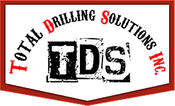- Home
- Drilling products
- Drill Bits
Drill Bits
Drill Bits
In rotary drilling, the process for opening a hole requires using a cutting element, which is done with drill bits. Bit selection and operation conditions are the most important factors to be considered by technicians. It is important to have the best equipment and advice in the market. You will find this at TDS. With our team of experts you could be saving up to 75% of your drilling costs by selecting the right drill bit for your needs, increasing your average rate of penetration, reducing trips, drilling straighter and improving hole stability.
TDS has available the following bits thread connections and sizes:
-
- Bit size 3 5/8″ – 4 7/8” | Thread 2 3/8 API
- Bit size 5″ – 5 5/8″ | Thread 2 7/8 API
- Bit size 5 3/4″ – 6 3/4″ | Thread 3 1/2 API
- Bit size 7 7/8″ – 8 3/4″ | Thread 4 1/2 API
- Bit size 9 1/2″ – 12 1/4″ | Thread 6 5/8 API
- Bit size 9 1/2″ – 12 1/4″ | Thread 6 5/8 API
- Bit size 12 1/4″ – 15″ | Thread 7 7/8 API
Tri-cone bits is historically the most used in rotary drilling operations due to its wide range of teeth and bearings allowing its use in many types of formations. Three cones rotate around their axles as does the bit on bottom. TDS supplies the tri cone bit for your needs with water wells and oil wells.
Drilling action of this kind depends of cone decentralization. This is caused when the cone periodically stops when the bit is rotating and scrapes the bottom hole. This tends to increase the rate of penetration in most kind of formations. The cone decentralization angle varies. TDS supplies any configuration required for a tri cone bit
Additionally, TDS can suit your budget, supplying new, premium and re-run tri cone bits. We utilize the IADC code when you order a tri cone bit to ensure it complies with your expectations. Our premium tri cone bits haves gauge protection with tungsten carbide, skirt tail hard facing, high end sealed bearings and optimized hydraulics. They are the most successful competitive bit in our catalog.
We supply tri cone bits ranging in size from 3.875” (88.9mm) to 28” (711.2mm), and Mill Tooth tricone bits ranging in size from 5” (127mm) to 32” (812.8mm).
IADC Classification:
The IADC tri cone bit is a standard widely used bit in the drilling industry. This classification system consist of four digits where the first three characters are always numbers and the last character is alphabetical.
First character “Series” (1 through 8):
The first character refers to bit series where 1 through 3 applies to milled tools. Series 1 represents the softest formations and series 3 the hardest and most abrasive. Both are for applications with milled tooth bits. Series 4 through 8 applies to insert-type bits: series 4 represents the softest formations and series 8 the hardest and most abrasive.
Second character “Type” (1 through 4):
Represents bit type, insert or milled tooth and describes degree of formation hardness. The type ranges from 1 through 4, where the highest number represents the hardest formation.
Third Character “Bearing design and gauge protection” (1 through 7):
Bearing design and gauge protection defined by IADC are as followings:
non-sealed roller bearing (also known as open bearing bits)
air-cooled roller bearing (designed for air, foam or mist drilling applications)
non-sealed roller bearing, gauge protected
sealed roller bearing
sealed roller bearing, gauge protected
sealed friction bearing
sealed friction bearing, gauge protected. Note that “gauge protected” indicates only that a bit has some features that protect or enhances bit gauge. It does not specify the nature of the feature. As examples, it could indicate special inserts positioned in the heel row location (side of the cone) or diamond-enhanced inserts on the gauge row.
Fourth Character “Included features”:
This category is considered optional and usually is defined by manufacturers. IADC identifies only 16 features but in some cases manufacturers combine many of them into an additional one.


